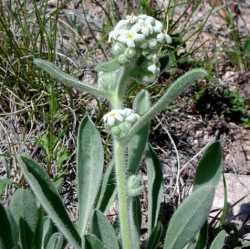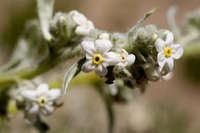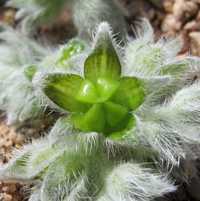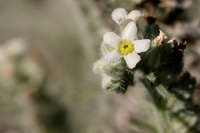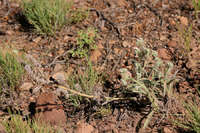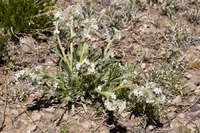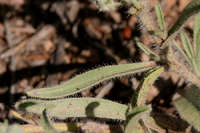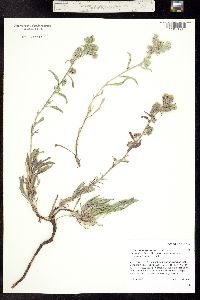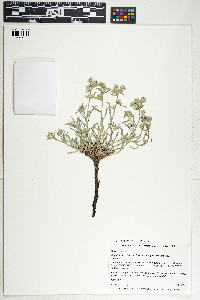|
Family: Boraginaceae
James' cryptantha
[ Cryptantha cinerea var. jamesii (Torr.) A. Cronquist, moreCryptantha jamesii (Torr.) Payson, Cryptantha jamesii var. disticha (Eastw.) Payson, Cryptantha jamesii var. typica Payson, Cryptantha suffruticosa (Torr.) Piper, Krynitzkia jamesii (Torr.) A. Gray] |
FNA 2004, Jepson 1993, Kearney and Peebles 1969 Duration: Perennial Nativity: Native Lifeform: Subshrub General: Herbaceous perennials, to 20 cm tall, prostrate to ascending, stems arising from a caudex with a basal rosette, branching from the base as well as above, herbage silvery-white in appearance, surfaces pustulate, covered with long hairs and stiff white bristles, these bulbous at the base. Leaves: Opposite below, alternate above, linear to oblanceolate, 1-9 cm long, upper surfaces strigose, lower surfaces strigose and bristly. Flowers: Small, white, the calyx 5-6 mm long, 6-8 mm wide, 5-parted, the corolla tubes with conspicuous crests at the base, sepals 2-4 mm, 4-7 mm in fruit, the throats generally yellow, inflorescences with soft hairs and few bristles, borne in elongate and open (in fruit) to scorpioid (in flower) cymes. Fruits: Fruits of 1-4 smooth, shiny nutlets, 1.5-2.5 mm, curved inward, not compressed. Ecology: Found on dry, sandy or gravelly soils in open, grassy woodlands, often among pinyon-juniper and oak, from 5,000-7,000 ft (1524-2134 m); flowering April-September. Distribution: Montana, south to California, east to Texas. Notes: Although the common name for this species is James' cryptantha, and some sources cite C. jamesii as a synonym for C. cinera, this synonym is not formally accepted by ITIS or Tropicos, who list C. jamesii as a variety of C. cinera. See FNA Vol. 15 (Boraginaceae) for a definitive source. For additional research, see the basionym Oreocarya cinera. Ethnobotany: A poultice of the pounded plant was applied for body pains, and the powdered root was used for a sore anus. The plant was used for sheep feed. Synonyms: None Editor: LCrumbacher 2011 Etymology: Cryptantha comes from the Greek krypto, "hidden," and anthos, "flower," a reference to the first described species in the genus which has inconspicuous flowers that self-fertilize without opening; cinera means ashy-gray, usually referring to the foliage, and jamesii is named after Dr. Frederick C. James (1935-2002). |


